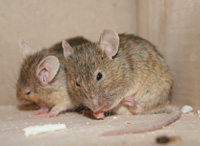During the winter months, it’s nice to have a cozy, warm place to come home to - but not if you’re sharing it with pests. Just like people, pests seek shelter from the cold weather and your home may seem like just the place to spend the winter.
 According to the National Pest Management Association (NPMA), rodents alone invade an estimated 21 million homes in the U.S. each winter. Mice and rats can spread diseases like salmonella and hantavirus when they contaminate food. Rodents can also bring other pests like fleas, ticks and lice indoors and can also cause damage to a home by chewing through wood and electrical wiring.
According to the National Pest Management Association (NPMA), rodents alone invade an estimated 21 million homes in the U.S. each winter. Mice and rats can spread diseases like salmonella and hantavirus when they contaminate food. Rodents can also bring other pests like fleas, ticks and lice indoors and can also cause damage to a home by chewing through wood and electrical wiring.Other cold-weather squatters include ants, spiders and cockroaches. More than a nuisance, many household pests can trigger allergies and asthma attacks, spread disease, transmit bacteria, contaminate food and, in some cases, bite or sting.
Pests can hitch a ride into your home on items brought indoors, such as firewood and foliage, as well as on family pets. They also gain entry through small cracks and crevices in a home’s exterior.
“Pests including cockroaches, ants, spiders and especially rodents are common home invaders in the winter,” says Missy Henriksen, vice president of public affairs for the NPMA. “An infestation by these pests can cause serious health and property issues if not properly dealt with in a timely manner. However, homeowners can help prevent infestations by taking a proactive approach.”
There are several effective pest-proofing measures you can use to discourage these unwanted guests from moving indoors for the winter. Homeowners or residents should:
• Seal cracks and holes on the outside of the home.
• Store items that are kept in garages, basements and attics in plastic, sealed containers rather than cardboard boxes to prevent rodents from nesting inside.
• Keep branches and shrubbery trimmed away from the home.
• Store firewood at least 20 feet from the home and five feet off the ground.
• Install door sweeps that help close the bottom gap on exterior doors, and repair damaged screens.
• Screen vents and openings to chimneys.
• Store food in airtight containers and dispose garbage regularly.
• If an infestation is suspected, contact a local pest professional.










